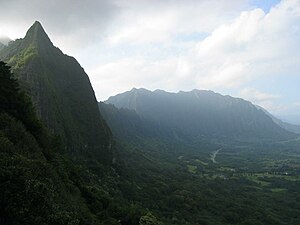Battle of Nuuanu
| Battle of Nuʻuanu | |||||||
|---|---|---|---|---|---|---|---|
| Part of Unification of Hawaii | |||||||
 Windward side of the Pali |
|||||||
|
|||||||
| Belligerents | |||||||
| Kamehameha I's army | Oʻahu army Kaʻiana's defector army |
||||||
| Commanders and leaders | |||||||
|
Kamehameha I John Young |
Kalanikupule Kaʻiana † |
||||||
| Strength | |||||||
| 10,000- 16,000 | Unknown | ||||||
| Casualties and losses | |||||||
| 300 — 10,000 for both combatants | |||||||
The Battle of Nuʻuanu (Hawaiian: Kalelekaʻanae; literally the leaping mullet), fought in May 1795 on the southern part of the island of Oʻahu, was a key battle in the final days of King Kamehameha I's wars to unify the Hawaiian Islands. It is known in the Hawaiian language as Kalelekaʻanae, which means "the leaping mullet", and refers to a number of Oahu warriors driven off the cliff in the final phase of the battle. There are "varied and sometimes conflicting histories of the Battle of Nuʻuanu."
Around the year 1792 (the exact date is unknown; the landing could have been as late as February 1795), Captain William Brown, an English merchant, landed in the harbor of Honolulu. As a Maritime Fur Trader and gun seller, he made several voyages before from the Pacific Northwest coast to the Hawaiian islands in command of the Butterworth Squadron. Captain Brown landed several vessels on the island; the ones noted are the two sloops Prince Lee Boo and the Jackall.
After landing, he made an agreement with Kahekili II (the chief of the island at that time) that he would offer his military assistance against Kamehameha for use of the harbor. Likewise, Kamehameha requested military assistance and the use of artillery from Captain George Vancouver and in exchange "ceded" the island of Hawaii to Great Britain in February 1794.
The two rival chiefs never met again, as Kahekili II died in mid-1794. At this point, Kahekili's son, Kalanikupule, had control of the island of Oʻahu and his half-brother, Kaʻeokulani, had control of the islands of Kauaʻi (through his wife), Maui, Lanaʻi, and Molokaʻi.
After Kahekili's death, Kaʻeokulani decided to visit Kauaʻi, his home island. In order to accomplish this, he had to travel through the way of Oʻahu. Kalanikupule then set up trenches and earthworks on the windward side of Oʻahu, where Kaʻeokulani's canoes would pass. Both sides fought, but the battle was stopped by Kalanikupule and the two chiefs met to mourn over the death of Kahekili.
...
Wikipedia
